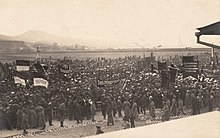Green Ukraine
Green Ukraine Зелений клин | |||||||||
|---|---|---|---|---|---|---|---|---|---|
| 1917–1922 | |||||||||
 Proposed territory of Green Ukraine | |||||||||
| Head of government | |||||||||
• 1918—1922 | Yurii Hlushko | ||||||||
| Historical era | Russian Civil War | ||||||||
• Established | 24 June 1917 | ||||||||
• Independence | April 1918 | ||||||||
• Disestablished | 1922 | ||||||||
| |||||||||
| Today part of | Russia | ||||||||
Green Ukraine,[a]also known asZelenyi Klyn[b]orZakytaishchyna,[c][note 1][3][4]is a Ukrainian name for a would-be independent Ukrainian state in the southernRussian Far Eastarea between theAmur Riverand thePacific Ocean,an area roughly corresponding toOuter Manchuria.

After the establishment of theBolshevikFar Eastern Republicon April 6, 1920, Far Eastern areas with a significant ethnicUkrainianminority population discussed the possibility of establishing an entity called Green Ukraine.[5][6][7]This movement quickly proved abortive.
Geographically, Green Ukraine borders the present-dayNorth Korea,in the special city ofRasonand the Chinese provinces ofHeilong gian gandJilin.
History
[edit]TheZeleny Klynwas an area of land settled byUkrainianswhich is a part of theRussian Far Eastin the area of theAmur Riverand thePacific Ocean.It was named by the Ukrainian settlers. The territory consists of over 1,000,000 square kilometres and has a population of 3.1 million (1958). The Ukrainian population in 1897 made up 15% of thePrimorskaya Oblast'spopulation.[8]
The territory was also informally known asUkrainian:Закитайщина,romanized:Zakytaishchyna,"Trans-China", i.e., "land beyond China".[9][10][11]
Zeleny Klyn became part of theRussian Empiremuch later thanSiberiaand other parts of the Far East. The first attempts at colonizing the area date back to the mid-17th century whenYerofey Khabarovfounded the fort ofAlbazinon theAmur River.From that time, constant skirmishes took place with theManchu peopleofChina.In 1689 China and Russia signed theTreaty of Nerchinsk,which granted Russia limited territory.

In the mid 19th century, the second Russian expansion took place after Russia lost theCrimean War(1853–1856). A number of Cossack settlements were established on the Amur river.Chinahad become far weaker than Russia at the time and ceded territory to Russia in theTreaty of Aigunof 1858 and by theConvention of Pekingof 1860 (seeAmur Annexation).
During this period, only a small number of settlers settled in the region consisting of some 14,000Cossacksand 2,500Russiansoldiers. In 1861, two oblasts were established, thePrimorskyandAmur.Khabarovskwas founded in 1858,Vladivostokin 1860.
In 1882, free transportation was announced for settlers to the area from Ukraine and free land was offered to settlers. By 1897, the population had increased to 310,000. With the establishment of the railroad in 1901, over 14,000 settlers were moving to the area per year, with a maximum of 78,000 settlers moving there in 1907.

After 1917,[citation needed]the area came under the jurisdiction of AdmiralAlexander Kolchak.In 1920, the Far East Republic was established as a buffer republic between Russia andJapan.In 1922, the republic joined with theRussian Soviet Federative Socialist Republic.In 1934, theJewish Autonomous Oblastregion was established with its capital atBirobidzhan.
Name
[edit]This term was also used forYellow Ukraine,Pink UkraineandGrey Ukraine.[12]
Proposed state
[edit]- 24 June 1917 – First All-Ukrainian Far Eastern Congress at Nikolsk-Ussuriyskyformed the Far Eastern KraiRada(Council).
- January 1918 – Second All-Ukrainian Far Eastern Congress atKhabarovskproclaimed Green Ukraine as part of the Ukrainian State (in spite of the lack of geographical connection).
- April 1918 – The Third All-Ukrainian Far Eastern Congress asked for the creation of an independent Ukrainian state on thePacific Ocean.
- Summer 1918 – The Far Eastern Ukrainian troops (more than 5,000) enlisted by GeneralBoris Khreschatitsky.
- 11 April 1920 – Order ofHetmanGrigory Semyonovon the right of Far Eastern Ukrainians for nationalself-determinationand autonomy in the limits of a united Far Eastern state ofCossacks,Buryats,and Ukrainians.
- 1922 – Dissolution of Green Ukraine.
Head of theKraiSecretariat:
- June 1918 – 1919 –Yuri Hlushko-Mova(1st time)
- January 1920 – 1922 – Yuri Hlushko-Mova (2nd time)
Territory
[edit]The Green Ukraine was located in theOuter Manchuria,extending acrossAmur River,Zeya,Svobodny,Blagoveshchensk,Ussuriland,to the north,Nikolayevsk-on-Amur,Khabarovsk,Vladivostok.to the south. The Green Ukraine had a roughly 2,500 km coastline along the Pacific Ocean that extended from theSea of Japan,to theSea of Okhotsk.Green Ukraine was nearby theSakhalin islandand theJapanese archipelago.
Religion
[edit]Most of theSlavicpopulation wereChristians.The localTungusic peoplesfollowed local religions; someAshkenazi Jewsin areas around the present-dayJewish Autonomous OblastpracticedJudaism.
See also
[edit]Notes
[edit]Lingual
[edit]Explanatory
[edit]- ^The flag of Green Ukraine appears to be a play on words on the concept of a "green wedge" combined with traditional Ukrainian colors. Ukrainian parlance also referred to other ethnic enclaves as "wedges" - note thatYellow Ukraine,Grey Ukraine,Pink Ukraine- compareUkrainian historical regions.
References
[edit]- ^Smith, Ned (24 February 2001)."Green Ukraine / Ukrainian Far East (1921, Russian Far East)".FOTW "Flags Of The World".CRW Flags.Retrieved24 October2018.
In "Flags of Non-Russian Peoples Under Soviet Rule" by Prof. Walter Trembicky [tbc69], pages 134 and 135, it mentions two proposed flags for Green Ukraine, or the Ukrainian Far East, neither of which was officially adopted, since the movement quickly proved abortive. There are simple black & white line drawings illustrating the two proposed flags on p. 133 of [tbc69]. The green in the two flags was described as dark or deep green.... One [of the two proposed flags] was the Ukrainian blue-over-gold bicolor with a green triangle at the hoist.
- ^Trembicky, Walter (1969).Flags of Non-Russian Peoples Under Soviet Rule.Flag Research Center. pp. 134, 135.
- ^"«Закитайщина». «Другая Украина» на Дальнем Востоке".Archived fromthe originalon 18 February 2018.Retrieved18 February2018.
- ^"Юрій Глушко (Мова) — Україна Incognita".Archived fromthe originalon 18 February 2018.Retrieved18 February2018.
- ^Jonathan D. Smele (2015).Historical Dictionary of the Russian Civil Wars, 1916-1926.Rowman & Littlefield. p. 476.ISBN9781442252813.
- ^"Всесоюзная перепись населения 17 декабря 1926 г".1927.
- ^"Зеленый Клин. Как украинцы осваивали дикие земли Дальнего Востока".28 January 2024.
- ^"Russian Census of 1897".Demoscope.ru.Retrieved2014-03-03.
- ^Андрій Манчук,«Закитайщина». «Другая Украина» на Дальнем Востоке
- ^Андрій Безсмертний-Анзіміров,Юрій Глушко (Мова)
- ^Smele, Jonathan D. (2015).Historical Dictionary of the Russian Civil Wars, 1916-1926.Rowman & Littlefield.p. 476.ISBN978-1442252813.
- ^Білий Д. Д. (1994).Малиновий клин (Нариси з історії українського населення Кубані).Київ: Україна.
Sources
[edit]- Encyclopedia of Ukraine,Volume 2, Paris 1957


